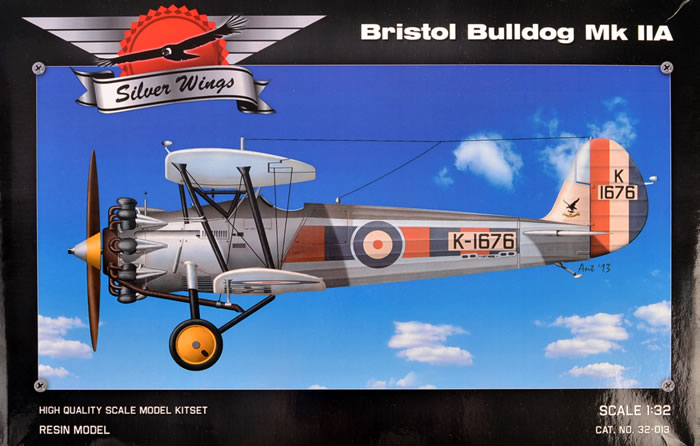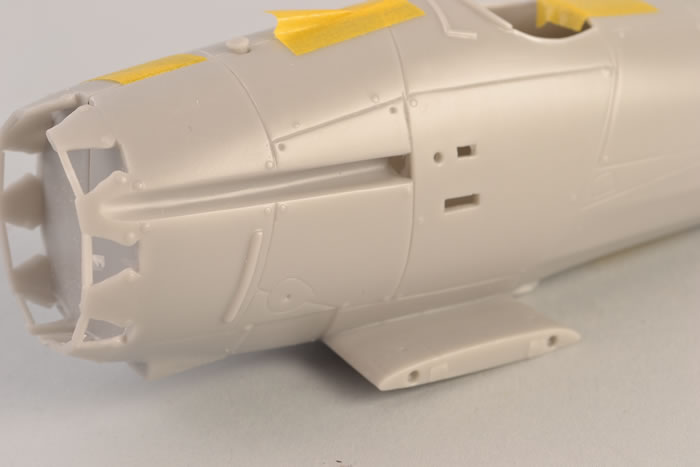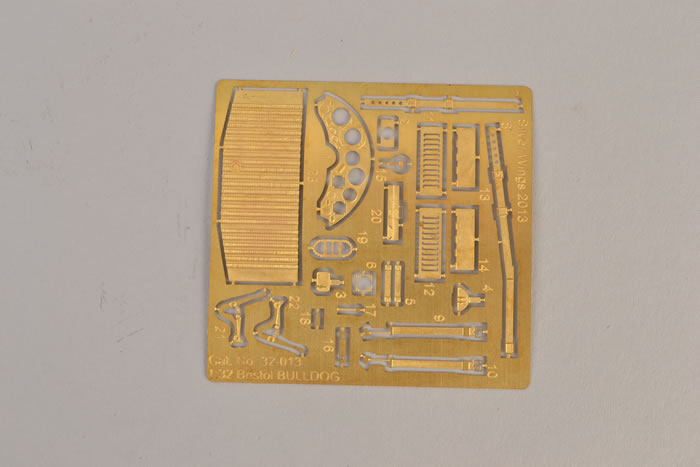|
Bristol Bulldog Mk.IIA

Silver Wings, 1/32 scale
S u m m a r y : |
Catalogue Number: |
Silver Wings Kit No. 32-013 - Bristol Bulldog Mk.IIA |
Scale: |
1/32 |
Contents & Media |
7 zip-lock bags containing 160 resin parts: one fret of 24 photo-etch metal detail parts; film containing instrument dials; markings for two aircraft: 16 page full color instruction booklet. |
Price: |
Available directly from some suppliers. Also available directly from Silver Wings, the price charged depending on the current exchange rate. |
Review Type: |
First Look |
Advantages: |
Excellent and builder friendly engineering; excellent representation of the surface details including fine panel lines and proper hatch openings; superb representation of fabric covered surfaces; crisp moldings with no casting blocks or pinholes; beautiful and sharply in-register decals; excellent instructions. |
Disadvantages: |
|
Conclusions: |
Lives up to the company credo of “Models for hobbyists by hobbyists”. A superb offering of a beautiful airplane and, depending on builders previous model building experience, a possible candidate for a first full resin kit or first bi-plane…..or both. |
Reviewed by Michael Scarborough

Valom's 1/48 scale An-2 Colt is available online from Squadron.com
The term Golden Age is one that is thrown around quite loosely in terms of model building. I started building models in the late 1950s and hold IPMS No. 119 and I believe I have seen a few Golden Ages in model building; Revell’s release of their first 1/32 kits; the beginning of recessed detail; the arrival of PE and aftermarket parts. However, for someone who likes biplanes and 1/32 scale I believe we are currently experiencing a true Golden Age. And, even more exciting for someone who grew up listening to stories of flight training at Pensacola in the 1930s, we are experiencing a Golden Age in aircraft from the true Golden Age of aviation during the inter-war years.
It does not take a lot of digging to find some rich nuggets of gold among the current producers of aircraft from the years spanning the two World Wars. Wingnut Wings has released several kits with decals from the 1920s. Fisher has just released a Ryan ST and Alleycat is producing a line of fine interwar biplanes upgraded from Montex kits.
Holding its own among these manufactures is Silver Wings models. Silver Wings is made up of a massive work force of two people and some friends: Wojtek Ku?akowski, owner and main master producer, and Simon Ku?akowski, his son and the company manager. They are joined as the need arises by a small group of old friends from the model business who specialize in making masters, designing graphics, casting resin and doing CAD and graphics software. One only need read the reviews of their models here on Hyperscale and across the model building web to hear oft repeated words such as excellence, quality, thoroughness, and, pride of craftsmanship. Indeed, Silver Wings credo is “Models for hobbyists by hobbyists". The box only needs opening for the new owner of the kit to say, “WOW….if I were going to produce a kit, this is the way I’d do it”.
But, “wait!” you say……isn’t that a resin kit and a bi-plane?? I respond, “Why do you ask? Do you suffer from Res-o-phobia – the fear of tackling a full resin kit? Do you suffer from Rig-o-phobia? – the fear of rigging a model airplane?” Well, fear not and read on, I have just the prescription for you: Silver Wings Bristol Bulldog Mk. IIA.
I will warn you ahead of time that this is a gushingly positive review so you may want to pull on some boots.
By pure luck, I recently bid on and won a Silver Wings Bristol Bulldog kit on eBay. My prior experiences with limited run kits had not been a happy ones and I was not prepared for the jaw-dropping high quality of the Bulldog kit when it first arrived. In the past, limited run kits had arrived in plain cardboard boxes with little or no guides for instructions and casting blocks in size and number that seemed to outweigh the kit parts themselves. To the contrary, this kit arrives and gives one the feeling that it has come from an artist’s studio as opposed to coming from a “manufacturer”.

My Bulldog arrived in a sturdy box with cover art that reminded me of the old days when the term, “suitable for framing”, really meant something. The kit parts are packed neatly in the box with subassemblies in zip lock bags and all safely wrapped in bubble wrap. The instructions are in the form of a beautifully printed 16 page color booklet. A history of the plane is given along with technical data and a list of the countries who can claim ownership of this attractive little biplane. The instructions are clear and concise and include a rigging guide.
The kit itself is comprised of 160 resin parts, none of which has a casting block attached!, 24 PE parts on one fret, a piece of film printed with the instrument panel and colorful decals. Surface detail is restrained and crisp. The few panels and access hatch openings that are present are done in fine, recessed lines. Thankfully, there is no attempt to simulate fabric covering in the incorrect manner done by some manufacturers. (Rant #1 - Having helped restore the Grumman FF-1 now in the Museum of Naval Aviation in Pensacola, I can speak from experience regarding a fabric covered airplane: yes, the structure is covered with fabric, often Irish linen. That fabric, however, is then covered with many coats of butyrate dope (I.e. paint) so that any cloth texture is buried leaving a smooth surface. Model manufacturers who insist on attempting to replicate the look of unfinished cloth should pay a visit to a museum to look at the real thing and then get their hands on a Silver Wings model to see how it is done in scale.)
Both the cockpit and the engine are highly detailed models in themselves. The cockpit is comprised of 45 resin and PE parts, while the engine, a well detailed Bristol Jupiter VII, is made up of 21 parts. These two subassemblies are so well detailed and crisply mastered and cast as to remind me of the interior of a Swiss Watch. Part of the Bulldog’s iconic look is in its cylinders protruding from the cowling. This gives the builder a golden opportunity to show off his or her skills at detail painting.

The engineering of the wings and struts show just how far some limited run kits have come. The upper wing is comprised of three sections. Mounting holes are provided in the outer sections and matching pins will be found on the center section. The same engineering is found on the lower wing/fuselage assembly. The struts thankfully come with wire reinforcing pins already imbedded. Location holes in the wings are clearly indicated but will need to be fully drilled out to accept the struts. Control surfaces on the wings and empennage are separate and, therefore, poseable. The proper dihedral for the wings is shown on page 7 of the instructions. With this combination of engineering and information, a builder with some experience will have no trouble with the twin wing assembly.
Rigging
Rant #2 - I wonder how many model builders have longingly looked at the recent releases of biplanes and wished to build them, but were put off for fear of rigging. It is my opinion that anyone with the skill to assemble a full engine or detailed cockpit has the skill to rig a biplane. It simply takes time and patience and a willingness to work with a new medium, namely, thread or stretched sprue. I believe that if you have worked with PE or resin aftermarket parts, or ever stretched sprue for an aircraft antenna, you have the skill in your fingers to rig a biplane model. The internet is full of how-to articles about rigging and many build reviews start off with a phrase like, “I’d wanted to build a biplane but was put off by rigging it…had I known how not difficult it actually was, I’d have built one long ago”. So, put the rig-o-phobia aside and jump in. In my opinion, when compared to a multi-bay plane like the Brisfit, or a boomed aircraft like the Dh. 2, the rigging on the Bulldog is minimal making it a fine candidate for a first rigged aircraft model. Don’t believe me? Go to their website, http://www.silverwings.pl/bristol-bulldog.html, pull up the pdf of the Bulldog instructions, and scroll down to page 14. There you will see a rigging guide comprised of 10 flying wires per side. That’s it. Go for it.
One note,….holes for the rigging are not already drilled out. This is not an omission, rather an example of how much thought has gone into the engineering of this kit. Silver Wings understands that builders wishing to rig a model have several different methods of anchoring the lines. Having no holes allows each builder to choose his or her own method of creating the holes. Also, if one should choose not to rig the model, no filling of holes will be necessary.
Decals
One set of national insignia is included while squadron markings for two aircraft are included. The decals come on two large sheets and are spot on in register and well saturated in color. They are printed by a group called HungAeroDecals, a company name that will surely bring a chuckle to builders with knowledge of American slang.

Aircraft represented are:
-
K 2159 19 Squadron, Duxford, 1931
-
K1676 23 Squadron, Kenley, 1931
Accuracy
Measurements were taken with a scale rule and compared to dimensions published in C.H. Barnes, Bristol Aircraft since 1910. No discrepancies were found. To my eye, the shape of the fuselage, flying surfaces and spinner are spot on.
Price
I apologize in advance for my final rant. Note that it is not directed at Silver Wings but at a few of my fellow model builders who complain about the cost of short run kits and after market detail parts. No one is getting rich making either and this sort of production can best be described, quite literally, as a labor of love. When compared to a mass marketed styrene kit such as a Spitfire or F-15, released by a major manufacturer, the price for any limited run resin kit will seem high. But considering the amount of research and work that is required for a two-person company like Silver Wings to produce an exquisite kit such as this, the comparison to the likes of Tamigawa is unfair. It is my belief that the amount of money I spend on a kit such as this Bulldog is in direct proportion to the amount of work that went into producing it.
Due to the nature of currency fluctuation, Silver Wings does not put prices on their website. Modellers wishing to purchase kits directly from them need only ask for the current price.
A model builders first full resin kit/biplane kit?
Yes, but please let me make this very clear: I do not advocate this kit for a beginning model builder. However, if you have reached the point where you are consistently and comfortably completing styrene builds, and if you have worked with aftermarket resin parts, I believe this is a next-step kit because it is so well engineered and builder friendly. One becomes a better model builder by building a lot of kits and by building kits of increasing difficulty. If you want to start further developing your building skills this is, in my very humble opinion, a fine choice as a first resin full kit. For the same reasons and those already stated, I also believe it is a good choice for a first biplane, and one that can be fully rigged should the builder choose. It is a colorful airplane with a beautiful form and would make a super addition to any collection.
Clearly, I am in love with this kit and I am already salivating over the upcoming P6E and Stearman. Monoplane fans can also expect a Reggiane 2000 Falco, a Yak 9 and a Fokker D. XXI, and, further down the line, WWII J-aircraft fans need to clear space for 1/32 kits of the Val and Kate. Let me add that all of these kits are being produced in response to polls taken on the various website forums. This is one company that listens to those of us who spend our money on their products.
Wojtek Kulakowski and his son Simon are gentlemen that are clearly interested in doing all they can to improve their products on behalf of us, the model building public. I hope they will be around for a long time and help prolong the Golden Age of model building we are now experiencing.
Kit purchased retail by reviewer
Text and Images Copyright © 2014 by Michael Scarborough
Page Created 15 April, 2014
Last updated
15 April, 2014
Back to HyperScale Main Page
Back to Reviews Page

|
